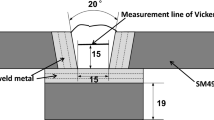Conclusions
An investigation was carried out into the microstructure and mechanical and operating properties of R6M5K5-MP high-speed steel produced from atomized powders with oxygen contents in the range 0.014–0.074%. Use of a powder containing more than 0.02% oxygen was found to have a pronounced deleterious effect on the quality of the sintered high-speed steel: Thick oxide films appeared in its microstructure at powder particle boundaries, and the impact strength of the metal and useful tool life decreased by factors of ∼1.6 and ∼1.5, respectively. In view of this, the maximum permissible oxygen content of this sintered high-speed steel may be taken to be 0.02 wt.%. The presence of even a minute quantity of argon in a capsule with powder led to the appearance of micropores (about 100 micropores in a 100-mm2 microsection area) in the resultant sintered high-speed steel, which shortened the useful life of tools made of this steel by a half compared with the nonporous steel. A larger argon content increased the amount of micropores and decreased useful tool life still further. The data obtained show that the presence of micropores in a sintered high-speed steel cannot be tolerated. The conditions for obtaining a nonporous steel from an atomized powder by HIP are an optimum capsule design and strong, gastight welds preventing argon from penetrating into the capsule with powder during pressing.
Similar content being viewed by others
Literature cited
A. K. Petrov, I. S. Miroshnichenko, V. V. Parabin, G. I. Parabina, G. N. Sergeev, Yu. G. Orlov, V. A. Golovko, and G. P. Brekharya, “Solidification of metal powders during the atomization of a liquid phase,” Poroshk. Metall., No. 1, 16–20 (1973).
G. I. Parabina, L. N. Marchenko, and V. T. Zubkova, “Properties of atomized powders,” in: Sintered High-Speed Steels for Tools [in Russian], Moscow (1977), pp. 8–11.
G. I. Parabina, A. G. Tsipunov, Yu. F. Bokii, L. N. Marehenko, and K. Kh. Magometov, “Defects in parts produced by hot isostatic pressing of atomized high-speed steel powders,” Poroshk. Metall., No. 7, 86–88 (1977).
P. Hellman, “Properties of high-speed steels produced by the powder metallurgy method,” Werkstatt Betrieb,108, No. 5, 277–279 (1975).
Author information
Authors and Affiliations
Additional information
Translated from Poroshkovaya Metallurgiya, No. 5(209), pp. 61–64, May, 1980.
Rights and permissions
About this article
Cite this article
Parabina, G.I., Kirillova, O.M., Palamarchuk, A.F. et al. Effect of oxygen and microporosity on some properties of a sintered high-speed steel. Powder Metall Met Ceram 19, 341–344 (1980). https://doi.org/10.1007/BF00791559
Revised:
Issue Date:
DOI: https://doi.org/10.1007/BF00791559




